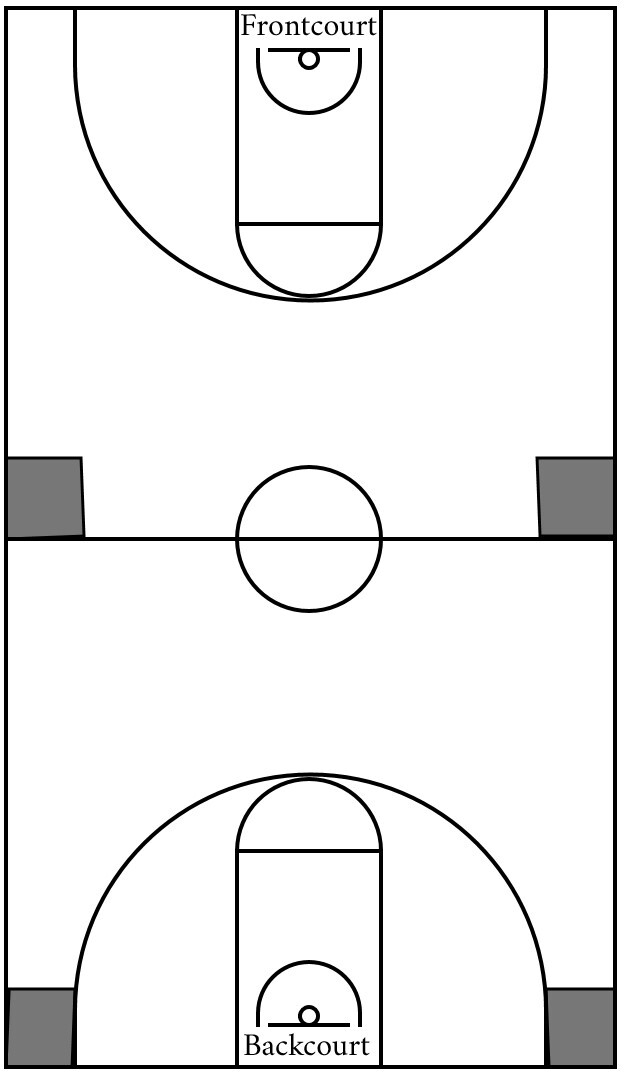Basic definition of coffin corner
The coffin corner is a term that is sometimes used to describe a corner area of the court that an offensive player in possession of the ball would have difficulty escaping from, specifically if that same offensive player gets trapped in that corner by two defenders.
Basic diagram example of coffin corner areas

This diagram shows the general coffin corner areas relative to an offensive player’s backcourt or frontcourt location.
In terms of the backcourt, the coffin corners are near the sideline and adjacent baseline. On the opposite side in relation to the frontcourt, the coffin corners are near the sideline and mid-line or half court line.
In essence, if an offensive player who is in possession of the ball within their team’s backcourt gets trapped in a coffin corner, then it would be typically difficult to escape from that trap, especially by passing backwards or by dribbling the ball.
Basically, if the player were to try an escape dribble by retreating backwards from the defenders while being trapped in a backcourt coffin corner, then that would lead to an out of bounds violation.
Additionally, if a player tried to dribble around the defenders, particularly away from the sideline, then that would probably be difficult as well, especially against one or more defenders who possess an adequate amount of lateral quickness.
Conversely, if the player were to try an escape dribble by retreating backwards while being trapped in a frontcourt coffin corner, then that would result in a backcourt violation.
Moreover, if a player tried to dribble around the trapping defenders, then that would be a challenge similar to the backcourt corner trap. At best, an offensive player could attempt to pass out of the trap but even that may be challenging due to the pressure and active hands of the defense.
In some instances, a player might be able to execute a split dribble between the two trappers but that is very risky; the end result most likely being a turnover.
So, to avoid this scenario from happening, offensive players in possession of the ball should try to stay away from the coffin corners as much as possible, especially if the defense is implementing some type of half court or full court press.
General summary
Generally speaking, the coffin corner is relative to the current backcourt or frontcourt location of an offensive player in possession of the basketball.
That is to say, if an offensive player has possession of the ball in their backcourt, then the coffin corners would be the corner areas near the baseline and sidelines.
Moreover, in a similar fashion, if an offensive player has possession of the basketball in their frontcourt, then the coffin corners would be the corner areas near the half court line and the the sidelines.
Essentially, the coffin corner areas are very similar in terms of their broad descriptions but the main difference depends on the corner location of the offensive player in possession of the ball.
It should also be noted that traps set near coffin corners are generally more effective because an offensive player usually has very limited options of breaking free from those particular traps.
Basically, once an offensive player in possession of the ball gets trapped in a coffin corner, that offensive player cannot dribble away from the trap, particularly to release defensive pressure because the baseline and/or sideline would act as a third quasi-defender.
Furthermore, if the offensive player were to dribble the basketball on or over the baseline/sideline, then that would result in an out of bounds violation.
What’s more is that once an offensive player gets trapped in the coffin corner, there is usually not enough space to dribble with any noticeable effect and because of that, the offensive player would usually be compelled to end their dribble by picking up the basketball.
From there, after the offensive player ends their dribble, the most practical options remaining at that point are to pass the ball to a teammate or call a timeout.
Unfortunately for the offensive player, it would usually be very challenging to pass the ball, especially over the outstretched arms of the trapping defenders.
Also, in certain instances, the offensive player would even be compelled to throw a jump pass to a teammate.
Nevertheless, if an offensive teammate is not open to receive that jump pass, then this could result in a turnover by way of a defensive interception or traveling violation, particularly when the offensive player lands on the floor after jumping into the air without releasing the ball.
As for the other option, calling a timeout after being trapped, particularly near a coffin corner, is usually the safest choice but the problem is that each team only has a limited amount of timeouts to use.
Therefore, burning a timeout, mainly because of trap defense, is usually not beneficial for the offensive team in the long run.
As an example, the offensive team might need to use a timeout during crunch time when the scores of both teams are close and simultaneously, there is very little time remaining on the game clock.
However, if a member of the offensive team already burned at least one timeout (if not more) after being trapped in coffin corners, then that could be an issue in terms of managing and executing special situations such as last second plays to win the game.